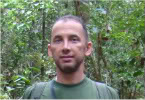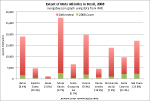Brazil has designated an additional 65,070 hectares (161,000 acres) of land to be protected in the Mata Atlantica, or Atlantic Forest. The land is split between four new protected areas and an expansion of a national park.
Once covering a significant portion of the eastern coast of South America, the Mata Atlantica, is one of the world’s most battered tropical forests. Today less than 7 percent of the ecosystem survives (just under 100,000 square kilometers) in mostly fragmented pockets after hundreds of years of exploitation and urban growth. Approximately 2 percent of Mata Atlantica’s historic range is under protection.
The new areas are meant to safeguard vanishing species, while also providing new opportunities for eco-tourism. Birding is especially important in the Mata Atlantica.
“This is one of the greatest victories for bird conservation in Brazil,” Jaqueline Goerck, director-president of SAVE Brasil told Birdlife International. “These new protected areas are all [Important Bird Areas (IBAs)], including two sites considered priorities for action by SAVE Brasil. When we initiated our work at these sites they were known by only a few ornithologists, now they are recognized at the national level, and the chances for the survival of an impressive number of threatened bird species have increased considerably.”
Some species that will benefit from the protected areas include the slender antbird (Rhopornis ardesiacus), listed as Endnagered by the IUCN Red List; the narrow-billed antwren (Formicivora iheringi), listed as Near Threatened; the pink-legged graveteiro, (Acrobatornis fonsecai) listed as Vulnerable; and the mantled hawk (Leucopternis polionotus), listed as Near Threatened.
The new protected areas include Alto Cariri National Park, Boa Nova National Park and Wildlife Refuge, the Serra das Lontras Forest Complex and National Park, as well as an expansion of Pau Brasil National Park.
Although little of the Atlantic Forest remains, the forest is still being lost. A study last year found that between 2000-2005 100,000 hectares of the forest were lost.
Related articles

(09/23/2009) The Atlantic Forest may very well be the most imperiled tropical ecosystem in the world: it is estimated that seven percent (or less) of the original forest remains. Lining the coast of Brazil, what is left of the forest is largely patches and fragments that are hemmed in by metropolises and monocultures. Yet, some areas are worse than others, such as the Pernambuco Endemism Centre, a region in the northeast that has largely been ignored by scientists and conservation efforts. Here, 98 percent of the forest is gone, and 70 percent of what remains are patches measuring less than 10 hectares. Due to this fragmentation all large mammals have gone regionally extinct and the small mammals are described by Antonio Rossano Mendes Pontes, a professor and researcher at the Federal University of Pernambuco, as the ‘living dead’.
Destruction of Brazil’s most imperiled rainforest continues

(05/31/2009) More than 100,000 hectares of Brazil’s most threatened ecosystem was cleared between 2005 and 2008, reports a study by the Fundação SOS Mata Atlãntica and the National Institute for Space Research (INPE). The “Atlas of Mata Atlântica Remnants”, released May 26, assessed the extent of the Mata Atlântica (Atlantic Forest) across 10 of the 17 states where the coastal rainforest occurs. It found that an 102,938 hectares were destroyed during the three year period. The annual loss of 34,121 hectares per year was 2.4 percent lower than the 34,965 ha recorded from the 2000-2005 period.
Brazil moves to protect and restore endangered Atlantic rainforest
(11/22/2008) Brazilian president Luiz Inacio Lula da Silva has signed a decree to protect and restore critically endangered rainforest along the country’s Atlantic coast, reports the Associated Press.







